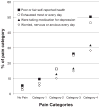Estimates of pain prevalence and severity in adults: United States, 2012
- PMID: 26028573
- PMCID: PMC4562413
- DOI: 10.1016/j.jpain.2015.05.002
Estimates of pain prevalence and severity in adults: United States, 2012
Abstract
Using a simple approach for coding pain severity, the present study describes self-reported pain in U.S. adults. Data are included for 8,781 adults who completed the Functioning and Disability Supplement of the 2012 National Health Interview Survey. An internationally piloted pain severity coding system was used to group participants into 5 discrete ordered pain categories based on their pain persistence (days with pain in the last 3 months) and bothersomeness (little, a lot, somewhere in between): pain free and categories 1 (low) to 4 (high). It is estimated that 126.1 million adults reported some pain in the previous 3 months, with 25.3 million adults (11.2%) suffering from daily (chronic) pain and 23.4 million (10.3%) reporting a lot of pain. Based on the persistence and bothersomeness of their pain, 14.4 million adults (6.4%) were classified as having the highest level of pain, category 4, with an additional 25.4 million adults (11.3%) experiencing category 3 pain. Individuals with category 3 or 4 pain were likely to have worse health status, to use more health care, and to suffer from more disability than those with less severe pain. Associations were seen between pain severity and selected demographic variables including race, ethnicity, preferred language, sex, and age.
Perspective: U.S. estimates of pain prevalence are presented using a simple approach for assigning pain severity developed by the Washington Group on Disability Statistics. Concurrent validity is assessed. Although this approach is promising, additional work is required to determine the usefulness of the Washington Group pain categories for pain research or clinical practice.
Keywords: Cross-sectional study; language preference; minority groups; pain frequency; pain severity.
Published by Elsevier Inc.
Conflict of interest statement
The author has no competing interests.
Figures









References
-
- Banks J, Kapteyn A, Smith JP, van Soest A. Work disability is a pain in the ****, especially in England, the Netherlands, and the United States. In: Cutler D, Wise D, editors. Health at Older Ages: The Causes and Consequences of Declining Disability among the Elderly. Chicago, Ill: University of Chicago Press; 2009.
-
- Barnes PM, Adams PF, Powell-Griner E. Advance data from vital and health statistics. 394. Hyattsville, MD: National Center for Health Statistics; 2008. [Accessed April 22, 2015]. Health characteristics of the Asian adult population: United States, 2004–2006. Available at: http://www.cdc.gov/nchs/data/ad/ad394.pdf. - PubMed
-
- Chowdhury PP, Balluz L, Strine TW. Health-related quality of life among minority populations in the United States, BRFSS 2001–2002. Ethn Dis. 2008;18:483–487. - PubMed
MeSH terms
Grants and funding
LinkOut - more resources
Full Text Sources
Other Literature Sources
Medical

